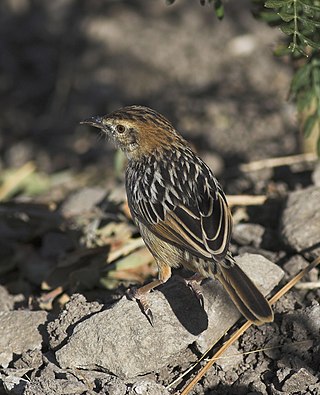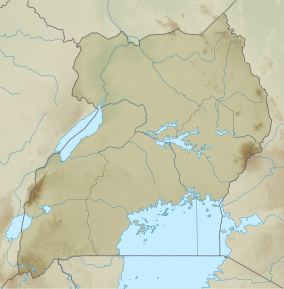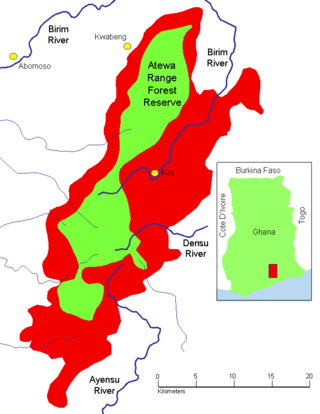
Mountain Elgon is an extinct shield volcano on the border of Uganda and Kenya, north of Kisumu and west of Kitale. The mountain's highest point, named "Wagagai", is located entirely within Uganda. Although there is no verifiable evidence of its earliest volcanic activity, geologists estimate that Mount Elgon is at least 24 million years old, making it the oldest extinct volcano in East Africa. The mountain's name originates from its Maasai name, Elgonyi.

Mount Moroto, also Moroto Mountain, is a mountain in the Northeastern part of Uganda.

The East Sudanian savanna is a hot, dry, tropical savanna ecoregion of Central and East Africa.

The Mabira Forest is a rainforest area covering about 300 square kilometres (120 sq mi) in Uganda, located in Buikwe District, between Lugazi and Jinja. It has been protected as Mabira Forest Reserve since 1932. It is home for many endangered species like the primate Lophocebus ugandae.

The wildlife of Cameroon is composed of its flora and fauna. Bordering Nigeria, it is considered one of the wettest parts of Africa and records Africa's second highest concentration of biodiversity. To preserve its wildlife, Cameroon has more than 20 protected reserves comprising national parks, zoos, forest reserves and sanctuaries. The protected areas were first created in the northern region under the colonial administration in 1932; the first two reserves established were Mozogo Gokoro Reserve and the Bénoué Reserve, which was followed by the Waza Reserve on 24 March 1934. The coverage of reserves was initially about 4 percent of the country's area, rising to 12 percent; the administration proposes to cover 30 percent of the land area.

The wildlife of Uganda is composed of its flora and fauna. Uganda has a wide variety of different habitats, including mountains, hills, tropical rainforest, woodland, freshwater lakes, swamps and savanna with scattered clumps of trees. The country has a biodiverse flora and fauna reflecting this range of habitats and is known for its primates, including gorillas and chimpanzees. There are ten national parks and thirteen wildlife reserves; some 345 species of mammal and 1020 species of bird have been recorded in the country.

The rattling cisticola is a species of bird in the family Cisticolidae which is native to Africa south of the equator, and parts of East Africa. It is a common to abundant species in open savanna and scrubland habitats, whether in arid, moist or upland regions. Especially during summer, it is highly conspicuous due to its strident and repetitive call-notes from prominent perches.

The stout cisticola is a species of bird in the family Cisticolidae. It is found in Angola, Burundi, Cameroon, Republic of the Congo, Democratic Republic of the Congo, Eritrea, Ethiopia, Kenya, Nigeria, Rwanda, South Sudan, Tanzania, Uganda, and Zambia. Its natural habitats are boreal forest, moist savanna, and subtropical or tropical high-altitude grassland.

The foxy cisticola is a species of bird in the family Cisticolidae.
The Bangangai Game Reserve is found in South Sudan, on the border with the Democratic Republic of the Congo, west of the town of Yambio. Established in 1939, it is both a game reserve and an Important Bird Area. This site covers 170 square kilometres (17,000 ha). Reserve is named after prominent 679 m height Bangani hill Chimpanzees are thought to habitate the game reserve; however, there is no recent information on their population.

The East African montane forests is a montane tropical moist forest ecoregion of eastern Africa. The ecoregion comprises several separate areas above 2000 meters in the mountains of South Sudan, Uganda, Kenya, and Tanzania.

The Imatong Mountains are mainly located in Eastern Equatoria in southeastern South Sudan, and extend into the Northern Region of Uganda. Mount Kinyeti is the highest mountain of the range at 3,187 metres (10,456 ft), and the highest point of South Sudan.

The East African montane moorlands is a montane grasslands and shrublands ecoregion which occupies several high mountain peaks in Kenya, South Sudan, Tanzania, and Uganda.
The Bugoma Forest is a protected tropical forest that is situated southwest of Hoima and northeast of Kyenjojo towns, and east of Lake Albert, in the Hoima district of western Uganda. It was gazetted in the 1932 and came under the mandate of the National Forestry Authority in 2003. But it was expanded in 1965, 1968 and 1998. Its surface area is given as between 41,144 hectares (411.44 km2) and 65,000 hectares (650 km2).

The Victoria Basin forest–grassland mosaic is an ecoregion that lies mostly in Uganda and extends into neighboring countries. The ecoregion is centered north and west of Lake Victoria, with an outlier on the border of Ethiopia and South Sudan.
Kasyoha-Kitomi Forest Reserve is located in Western Uganda, 35 kilometers from Bushenyi Town, South of Lake George and the Kazinga Channel, and covers an area of 433 square kilometers along the South of Lake George and Kazinga channel in the Albertine region. The reserve is situated in the administrative districts of Bushenyi, Rubirizi, Ibanda and Kamwenge.
Kasyoha-Kitomi Central Forest Reserve is located in Western Uganda, and has an area of 433-square-kilometre (107,000-acre). It is located south of Lake George and the Kazinga channel in the Albertine Rift eco-region, which is known for its abundance of endemic species. The forest reserve lies within the counties of Bunyaruguru, Igara and Buhweju in the administrative districts of Bushenyi, Ibanda and Kamwenge It was officially gazetted in 1932 and is controlled by Uganda's National Forestry Authority (NFA).
Lutoboka Central Forest Reserve is a protected area in Uganda's Eastern district of Kalangala. The 174 hectares Lutoboka Forest Reserve is located in Kalangala Town Council on Bugala Island.
Mount Kei Central Forest Reserve is a protected area located in Koboko district, in the extreme north-west of Uganda. It covers an area of 384 square kilometers and is known for its diverse ecosystem consisting of dense savanna vegetation, forest, scrubland and a wide range of wildlife.














